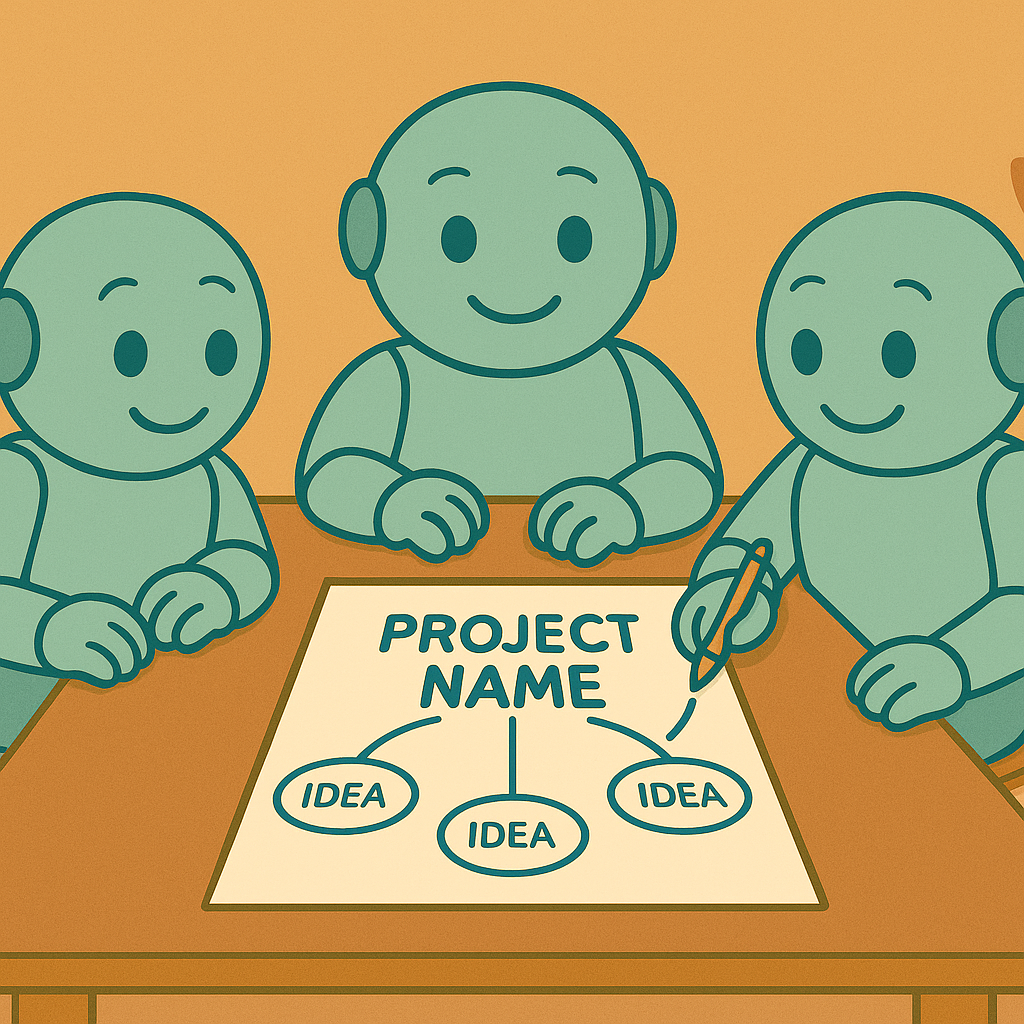Naming a Project: Tips for Creating Great Names
Why Your Project Name Is Your Secret Weapon

For many project managers, the task of naming a project often seems like a minor detail, frequently postponed until the very end. Experienced leaders, however, understand a significant truth: a project's name is more than a simple label. It acts as the foundational stone for building success, as this first identifier can strongly influence perceptions and engagement right from the start.
How exactly does a well-chosen name become your project's advocate? It achieves several key things:
- It offers instant clarity about the project's main objective, helping to align team members and stakeholders effectively.
- It helps build an emotional connection within your team, turning everyday tasks into missions that individuals feel a personal stake in.
- It sets a tone of credibility and professionalism even before your first detailed plan is shared.
This immediate understanding and connection are quite important. When a name clicks, it naturally encourages greater participation and a robust sense of shared identity, effectively converting team members into enthusiastic supporters of the project's objectives.
Building Momentum and Global Impact
A compelling project name conveys professionalism and careful planning, which can make stakeholders more open to your proposals. This initial positive impression is especially important when trying to secure support or funding for new undertakings, whether they are local or international.
When naming a project, organizations frequently weigh crucial elements like its primary aim, intended audience, and how it fits with the overall brand. This thoughtful approach is even more vital for projects that cross geographical boundaries, as these initiatives are often managed in varied cultural settings. For instance, with nations like Brazil, Russia, India, and China (BRIC) increasingly contributing to global economic expansion and project work, the strategic naming of projects in these areas greatly affects their success and worldwide acknowledgment. An apt project name that considers local cultural and economic details can notably improve teamwork among international groups, a crucial factor for project success. Explore global economic trends and project initiatives further.
In the end, a memorable and thoughtfully selected project name does more than just identify; it inspires. It has the capacity to elevate standard initiatives into movements people genuinely want to support and promote, setting the stage for meaningful outcomes throughout the project's duration.
The Essential DNA of Names That Stick
A project name capable of sparking significant engagement isn't a product of mere chance. It carries a unique DNA, a collection of fundamental components ensuring it connects profoundly and lasts well beyond the project's conclusion. Understanding these traits is vital when naming a project intended for substantial impact, distinguishing truly memorable identities from those that vanish quickly.
The most successful project names effectively blend several key factors. They provide instant comprehension while kindling curiosity, mirror core values while building a sincere emotional link with the team, and maintain professionalism while being distinctive. This thoughtful construction is why certain names actively contribute to a project’s progress and ultimate success.
Striking the Right Balance
A primary challenge in naming a project is achieving a balance between clarity and creativity. A name that is too vague may cause confusion, while one that is excessively literal can be uninteresting. The ideal often involves names that hint at the project's purpose or desired outcome in an engaging way, making even complex initiatives more accessible and understandable from the outset. For instance, a project aimed at simplifying internal communications might be named "Project Connect" (emphasizing clarity) or "Synapse" (a creative term implying connection).
Embedding Values and Forging Connections
Beyond mere description, a powerful project name should also reflect the organization's values or the specific ethos of the initiative. This imbues the project with a deeper meaning, fostering a stronger sense of ownership and emotional connection among team members. This connection isn't about being overly sentimental, but about creating an identity that people are proud to be associated with, which can significantly boost morale and collaborative spirit.
The journey to finding that perfect name often involves collaborative brainstorming, as illustrated in the mind map below where a team explores various project naming ideas. 
To better understand how these elements contribute to a name's effectiveness, consider the following comparison. This table breaks down key aspects of project naming, contrasting successful strategies with those that are less effective.
Project Naming Elements Comparison Comparison of effective vs ineffective project naming approaches across key elements
| Element | Effective Approach | Ineffective Approach | Impact on Success |
|---|---|---|---|
| Clarity | Hints at purpose or desired outcome; easily understood. | Obscure or overly complex, leading to confusion. | High: Facilitates immediate understanding and team buy-in. |
| Creativity | Engaging and memorable; sparks interest and curiosity. | Dull, overly descriptive, or uninspiring. | Moderate: Enhances memorability and team enthusiasm. |
| Value Alignment | Reflects organizational ethos or project-specific values. | Disconnected from core values; generic or meaningless. | High: Fosters a strong sense of ownership and emotional connection. |
| Memorability | Easy to recall, pronounce, and share. | Forgettable, difficult to pronounce, or easily confused. | High: Supports long-term recognition and project recall. |
| Cultural Sensitivity | Researched for global appropriateness; respectful of nuances. | Potentially offensive or meaningless in other cultures. | Critical: Prevents negative reception and potential brand damage, especially for global projects. |
This comparison highlights that effective project names are strategically crafted, balancing multiple factors to ensure they resonate positively and contribute to the project's objectives.
Global Considerations and Lasting Impact
Furthermore, in an increasingly interconnected world, cultural considerations are paramount, especially for projects with a global reach. A name that works well in one language or culture could be ineffective or even inadvertently offensive in another. Thorough checks and an awareness of linguistic nuances can prevent embarrassing missteps. Ultimately, evidence-based approaches—focusing on memorability, relevance, and positive association—consistently yield names that not only stick but also support the project’s long-term objectives.
Leveraging Modern Tools for Strategic Naming
The conventional method of brainstorming project names within a conference room setting is evolving. Contemporary, forward-looking teams are augmenting human creativity with data-informed insights to select names that genuinely perform when naming a project. This strategy facilitates a more considered and impactful name selection process from the very start.
AI-Powered Insights for Superior Name Selection
Modern AI tools offer capabilities far beyond simple suggestions; they furnish a sturdy, data-supported basis for your creative choices. These intelligent systems can substantially assist the process of naming a project by:
- Analyzing current market trends and consumer sentiment to identify pertinent themes.
- Generating name suggestions that align with specific project objectives and the established brand voice.
- Providing insights into which names are most likely to connect with your target audience. This systematic approach can remove a considerable degree of speculation from the initial phases of the naming process.
This data-centric methodology is particularly relevant because naming a project represents a foundational step in project management, establishing the initiative's character and identity. The increasing adoption of AI and hybrid approaches is fundamentally altering how projects are conceptualized and, subsequently, named. For example, AI tools can evaluate market tendencies and propose names that resonate with project aims and intended audiences.
This integration of AI supports more efficient project naming, helping organizations better define their brand identity in relation to project objectives. The importance of such tools is underscored by projections that the project management software market is expected to reach $7.24 billion by 2025, highlighting a significant movement towards digital solutions for automation and data analysis within project management. Discover more insights about project management trends here.
Streamlining Team Efforts and Performance Tracking
Beyond AI, a variety of collaborative platforms now exist to facilitate smoother team input and more transparent decision-making when naming a project. These tools centralize suggestions, support structured feedback, and keep discussions organized, ensuring all contributions are heard efficiently. You might be interested in: Business Name Generators: Naming Tools for Every Need.
Additionally, specialized software solutions are emerging that help track name effectiveness over time. This capability allows teams to measure the impact of their chosen names and derive lessons from past choices, creating an invaluable continuous feedback loop for future naming endeavors.
The Synergy of Automation and Human Creativity
Automation in the naming process introduces significant efficiency gains. Tasks such as initial screening for availability, basic linguistic checks, and even preliminary sentiment analysis can be managed rapidly by modern tools. This frees up valuable human resources to concentrate on the more strategic aspects of naming.
However, the ultimate objective is not to replace human input but to augment it. The human intuition that makes names genuinely compelling, culturally relevant, and emotionally resonant remains indispensable. For instance, while an AI might generate hundreds of technically sound names, a project team's deep understanding of subtle brand nuances or internal cultural dynamics is crucial for the final, impactful selection. Modern tools simply provide a stronger, more informed foundation for these critical human-led decisions.
Your Step-by-Step Naming Framework That Actually Works
Even with helpful tools available for naming a project, the actual decision-making process often benefits from a solid framework. Without one, discussions can become lengthy and bogged down by personal preferences, potentially harming good projects. This methodical approach provides a clear roadmap, from initial exploration to a well-reasoned final name selection, helping ensure your project's name is effective and memorable.
Strategic Research: Uncovering What Matters Most
The first crucial step, before any names are even thought of, is strategic research. This stage is all about getting to the heart of your project: What is its main goal? Who is it for? What key messages or values should it communicate? Answering these questions helps define the desired impression the name should create and the audience it needs to reach.
To build this understanding:
- Engage in detailed stakeholder interviews to gather different viewpoints and align on project goals.
- Examine the current environment: What names are common for similar projects or competitors, and how can your project stand out?
- Pinpoint the project's unique selling proposition – the primary advantage or benefit it offers.
Achieving this clarity early on will guide all subsequent naming activities, keeping them focused on the project’s core objectives.
Generating Creative Options: Beyond Basic Brainstorming
Once you have a solid grasp of the project's essence, it's time to develop a wide array of creative name options. Good leadership in these sessions is vital, encouraging more than just standard brainstorming. Techniques such as word association, exploring metaphorical thinking, or creating visual mood boards can spark fresh and suitable ideas.
Incorporating stakeholder feedback at this point is also beneficial, provided it's done systematically. Rather than asking for general suggestions, offer specific prompts based on the initial research. This method ensures the ideas generated are pertinent and align with the project's main goals, improving the efficiency of the naming task.
Evaluation and Decision-Making: Cutting Through Subjectivity
After compiling a list of possible names, the next hurdle is evaluation. To steer clear of choices driven by individual taste, it's important to set up objective evaluation criteria prior to reviewing the names. These standards should directly reflect your earlier strategic research: Does the name align with the project's primary aim? Is it distinctive and easy to recall? Is it straightforward to say and write?
This move towards a more methodical assessment is significant and mirrors broader trends in project management. For instance, the adoption of project management software is widespread, with 82% of companies reporting its use to improve operational effectiveness, as detailed in these project management statistics from monday.com. This indicates that the process of naming a project is also becoming a more organized activity, where decisions are informed by data, including market feedback and progress tracking. Furthermore, the increasing use of hybrid project approaches suggests a need for names that convey flexibility, especially as AI becomes more integrated into project workflows. Following these evaluation steps fosters agreement and results in a final name selection that the team can support with assurance.
Fatal Naming Mistakes That Kill Project Momentum
Even with a solid plan, selecting a project name can be tricky. Some common errors in naming a project can unfortunately halt promising work before it truly begins. Recognizing these potential traps is important so your chosen name boosts, rather than burdens, your project's momentum. A poorly chosen name may cause misunderstanding, lessen team involvement, and create internal difficulties.
The Pitfall of Puzzling Acronyms and Abbreviations
A frequent misstep is acronym overload. Although they might appear efficient, using too many acronyms for project names can result in a bewildering mix of letters that are hard for teams to recall or distinguish. For instance, a name like "Strategic Unified Business Initiative" might become "SUBI," which could be nonsensical or carry negative undertones. A notable example involves a company called "Sunshine Coast Art and Branding," which narrowly avoided the awkward acronym "SCAB."
Such errors don't just obscure meaning; they also dampen enthusiasm. Projects need strong support, and a name that sounds like technical shorthand seldom motivates a team. The objective is to select a name that connects with people, not one that needs deciphering.
The Problem with Plain and Generic Labels
Just as problematic are generic names that fail to generate any enthusiasm. Titles such as "System Update Phase 2" or "The Q4 Report Project" serve a basic function but do little to build excitement or convey a distinct mission. When naming a project, the goal should be to reflect its core and potential influence, helping team members feel connected to an important endeavor.
A non-descript name can unintentionally suggest the project is minor or ordinary, complicating efforts to gain resources or active involvement. Thoughtful naming can change this perception significantly. To explore more creative and meaningful ideas, consider Our Comprehensive Guide to Crafting the Perfect Name.
Overlooking Cultural Nuances and Stakeholder Views
Another significant area where naming a project can falter is through cultural insensitivity or by not aligning with stakeholder expectations. A name that is appealing in one language or location might be offensive or meaningless elsewhere; this is an especially important point for international projects. Likewise, if key stakeholders are excluded from the naming process, or if a name is imposed without consultation, it can cause dissatisfaction and reduced participation from the outset.
Common Naming Traps and Effective Solutions
Successfully managing internal dynamics and securing widespread approval for a project name requires careful planning. Steering clear of frequent errors is vital for preserving your project's distinct identity and drive.
To better understand these challenges, the table below details common project naming mistakes, explains their pitfalls, and offers more effective alternatives along with an assessment of their potential for success.
Common Project Naming Mistakes Analysis of frequent naming errors and their solutions with impact assessment
| Mistake Type | Example | Why It Fails | Better Alternative | Success Rate |
|---|---|---|---|---|
| Acronym Overload | Project "A.R.T.E.M.I.S." (Advanced Resource Tracking & Management Info System) | Becomes a jumble of letters, difficult to remember, lacks connection, can be awkward. | An evocative name like "Project Insight" or "ResourceFlow" | High |
| Overly Generic | "The Process Improvement Initiative" | Fails to motivate, doesn't stand out, conveys no unique value or excitement. | A name tied to benefits or vision, e.g., "Project Momentum" or "NextLevel Ops" | Significant |
| Culturally Insensitive/Awkward | Name with negative translation or unintended meaning in another culture. | Causes offense, harms reputation, may alienate global teams or markets. | Thorough linguistic and cultural checks for all proposed names. | Critical |
| Difficult to Pronounce/Spell | "Project Ghyllghwynnedd" | Creates communication issues, hinders word-of-mouth, people may avoid saying it. | Simple, clear, and easy-to-say names. | High |
| Ignores Stakeholder Input | Name chosen by one person, disliked by the team. | Leads to low buy-in, dissatisfaction, and undermines teamwork and project identity. | An inclusive naming process with clear guidelines and open decision-making. | High |
Understanding these common naming errors allows you to guide your naming a project efforts toward a result that genuinely supports your initiative. This helps build a strong project identity right from the start.
Testing Your Name Before Going All-In
Once you've worked through potential naming issues and compiled a promising list of options, the process of naming a project moves into an essential testing stage. Prudent organizations recognize the risk of selecting a project name without thorough evaluation. This vital step confirms that your chosen name connects well with its intended audience and aligns with project objectives, preventing it from becoming an unexpected problem.
The main goal of this testing is to collect insightful responses, particularly from key stakeholders whose support is vital. It's more than just a popularity contest; the focus is on comprehending how the name is perceived, what it suggests, and any possible sources of confusion. These responses form the foundation for a well-considered final choice.
Designing Your Name Test
Successful testing for naming a project starts with a clear understanding of what information you aim to gather. Your tests should be structured to produce actionable insights, rather than just general preferences. For example, asking specific questions that probe underlying comprehension and sentiment is more useful than a basic preference survey.
When creating your test, pay attention to these key areas:
- Memorability: How readily can someone remember the name after a brief interval? A simple recall exercise can provide valuable data.
- Clarity: Does the name clearly suggest the project's function, or does it create confusion?
- Pronunciation and Spelling: Can the name be spoken and written without difficulty? Names that are hard to pronounce or spell can impede clear communication.
- Associations: What ideas, emotions, or visuals does the name bring to mind? It's important these are favorable and match the project's goals. Word association tasks can reveal underlying connotations.
- Unintended Meanings: Review for any potentially awkward acronyms or phrases. For instance, ensure a project titled "Strategic Tech Advancement Initiative" doesn't lead to an undesirable abbreviation.
Making Sense of the Feedback
After collecting the responses, the subsequent task is to analyze them objectively. It's important to avoid becoming defensive if a preferred name doesn't receive positive feedback. Concentrate on identifying trends within the responses instead of dwelling on individual remarks. The objective is to grasp the overall sentiment and understanding.
While detailed statistical work isn't always required, specific metrics do matter. These can include the percentage of people who correctly remember the name, how many connect the name to the project's main purpose, or the balance of positive to negative associations. Such information aids in weighing various stakeholder opinions while keeping the project's objectives in focus. If early testing indicates your current selections are not performing as hoped, resources like NameRobot's guide on Naming Inspiration can provide fresh ideas.
Formal vs. Informal Validation Approaches
Name testing can be conducted using various methods, from formal research techniques to more casual evaluations. Formal approaches, such as moderated focus groups or meticulously designed surveys distributed to a relevant segment of your audience, can yield substantial qualitative and quantitative information. These are especially beneficial for projects with significant implications.
Conversely, informal validation can also offer valuable insights, particularly for internal projects or when time and budget are constrained. Examples include:
- Conducting brief opinion polls among different departments.
- Sharing potential names with a compact, varied group of reliable peers for their initial thoughts.
- Holding individual conversations with principal stakeholders.
In the end, testing instills the assurance that you are selecting an asset for your project, not merely a label. This process helps you identify a name that is genuinely effective, allowing for data-driven adjustments until you arrive at the option best suited to advance your project.
Launching Your Project Name for Maximum Impact
A carefully chosen name, born from a thorough naming a project process, needs a well-planned introduction to truly make a difference. Without a strategic launch, even the most fitting project name might not connect with people, leading to misunderstandings or a lack of interest. The real impact of a name is realized when it's presented thoughtfully and adopted throughout your organization.
Crafting the Introduction: More Than Just an Announcement
To effectively introduce your project name, you need more than a simple announcement; you need a compelling introduction narrative. It's about telling the story behind the selection. Clearly articulate the 'why'—how the name aligns with the project's purpose, its future goals, and the advantages it will bring. This insight is vital for securing initial buy-in from stakeholders.
For instance, when you share the new name, demonstrate how it mirrors the project's fundamental objective. If "Project Nova" was selected for an initiative designed to usher in fresh starts, the introductory story should emphasize this symbolic meaning. This helps team members form a connection with the name's inspiring nature, turning a basic label into a significant identifier.
Reinforcing the Identity: Supporting Materials and Consistent Use
After the initial reveal, developing supporting materials is important for strengthening the name's meaning and presence. These items act as regular prompts and assist in integrating the name into the company's everyday activities. Consider elements such as:
- Visual assets: Basic visual elements or internal branding connected to the name.
- Internal communications: Uniform application of the name in all emails, paperwork, and presentations.
- Brief guides: Outlines detailing the name's background and proper application for clear understanding.
Consistent application across all points of contact is crucial for making the name a fundamental aspect of the project's identity. This uniformity helps to prevent previous or informal names from persisting, promoting a shared understanding and recognition.
Maintaining Momentum and Measuring Adoption
The introduction is only the first step; maintaining momentum over the project's entire duration is equally significant. Consistently referring to the project by its official designation in progress reports and acknowledging achievements under this name will keep it current and meaningful.
It is also advisable to measure name adoption among various teams. Straightforward methods like observation, feedback mechanisms, or casual surveys can show how effectively the name has been accepted. Should you face any reluctance, tackle it by re-sharing the name's story and emphasizing its advantages. Occasionally, a name simply requires a period of adjustment and steady, positive reinforcement to gain full acceptance. Making the name announcement an engaging event can greatly help build enthusiasm for the project.
If you're ready to find the ideal name for your upcoming project, consider using NameRobot. It can assist you with each phase of the naming a project process, from initial idea generation to trademark verifications. Explore a more effective approach to naming by visiting their website.















